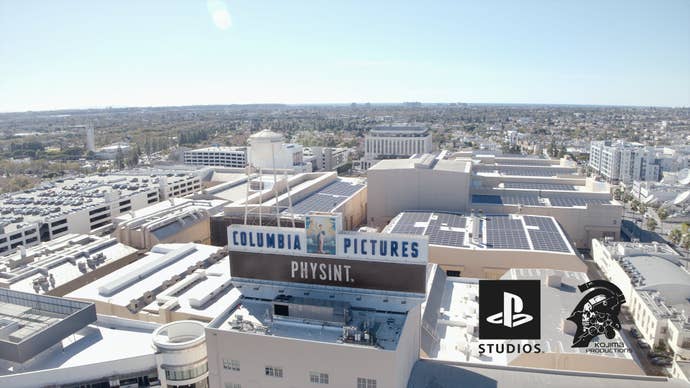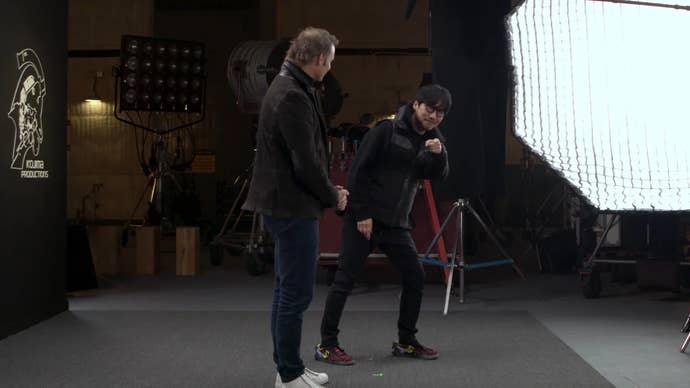Physint isn't Kojima coming home to PlayStation – how can it be, when he never left?
The Martin Scorsese of gaming is coming home... well, he would be if his legacy never left Sony and the PlayStation brand in the first place.
With the recently-announced espionage action game Physint, Hideo Kojima is going back to where it all began. Not literally, of course. He’s not cracking out the MSX, even if Sony did also have a hand in that. Nor is he going back to Konami (can you imagine?) No, Kojima is back to his spiritual home, PlayStation, and quite rightly the console maker is making all the right noises about that.
How many other designers/directors get to promote their games by standing there looking bashful while senior executives tell them how much they love them, and then a drone whizzes out of a studio soundstage into the skies of LA and, and, presumably, trumpeters play triumphantly whenever he enters or exits a room? Exactly.
The funny thing is that, despite all the fanfare, he never truly left. PlayStation is the house that Kojima helped build, and his influence is still keenly felt in the company’s first-party studio, consciously or otherwise. By and large its ‘big’ games are resolutely single player, ‘cinematic’ experiences heavy on the trappings of blockbuster movies. (Occasionally there will be a multiplayer mode, but more often than not it’s an interesting failure.) This is not to say that God of War or Uncharted or The Last of Us are thematically or mechanically similar to, say, MGS, but that the underlying aesthetic influence is the same: cinema cinema cinema, particularly of an American persuasion.
Kojima’s genius, however, wasn’t just aping cinema. It was marrying it to the form of video games in a way that the slew of imitators then and now didn’t really seem to understand. The original MGS’s most memorable moments aren’t necessarily the Hollywood-inflected ones: it’s Psycho Mantis reading the memory card. It’s ‘HIDEO’. It’s swapping controller ports. It’s the code on the back of the game’s physical box. In MGS3, it’s playing with time-honoured fail states to defeat a boss via the revival pill, or putting the clock forward on your console to cause an enemy to die of old age. In short, it’s the things that only games can do.

When Kojima gets away from that line of thinking, in his stealth games at least, things tend to go awry. MGS2 and MGS4 went long on cutscenes and short on the level of playfulness found in MGS and MGS3, and suffered for it. (Your mileage may vary, of course, but – admirable and ambitious deconstruction of sequel expectations aside – the Big Shell isn’t the world’s most inspired playground.) So, we’ll have to see how much the ‘movie’ element of Physint dictates the play element, but given the Sony/Columbia connection and Kojima mentioning Sony’s distribution and music/film studio businesses, we can probably say that it’ll be substantial in one way or another.
There is also talk, from Kojima himself no less, about this game being the culmination of his legacy. This is where things can get tricky for any director, especially those in film. As he will know himself, history is filled with directors who made their true classics while chasing that elusive ‘dream’ project which either fails to materialise or simply just fails (in other cases, there are films which did materialise but were lost or butchered by the studio: Orson Welles’s second feature, The Magnificent Ambersons, being perhaps the most notorious example.)
While it’s fun to imagine what Stanley Kubrick’s Napoleon would have been like, or what Francis Ford Coppola’s long-in-the-making-and-allegedly-still-to-be-made Megalopolis will be, when push comes to shove what becomes the defining work of any artists is dictated not just by themselves but the audience. Napoleon or Ambersons or Megalopolis may have been incredible (and in once case legitimately was), but they are not and never will be Citizen Kane, The Godfather, or 2001: A Space Odyssey.

Besides, Kojima’s legacy is already bigger than one game, or one film, even if he does go on to actually make a feature. Kojima’s excitement about the might of Sony’s multimedia empire is well-founded: after all, he’s been here before. It’s difficult to overstate just how much the original PlayStation changed the game in distribution and logistics channels alone, all provided by Sony’s interests in the CD format and the music industry.
These got the machine set for domination as much as the hardware and the games, so when Final Fantasy VII and Metal Gear Solid came along to take advantage of all of that, in terms of voice acting alone they essentially, if not invented, then at least popularised ‘talkies’ for the gaming world. For a movie nerd like Kojima, that’s some legacy.
As it stands, he reminds me of a gaming version of Martin Scorsese: brilliantly gifted in his field, some staggering classics to his name, and at a point in his career where major studios will give him loads of money to essentially do whatever he wants. Not too bad a comparison for any film lover.
Perhaps Physint will be the culmination of his legacy, although I have my suspicions it won’t be. And if I’m wrong, well, everyone wins. Just keep the cutscenes under half an hour.
